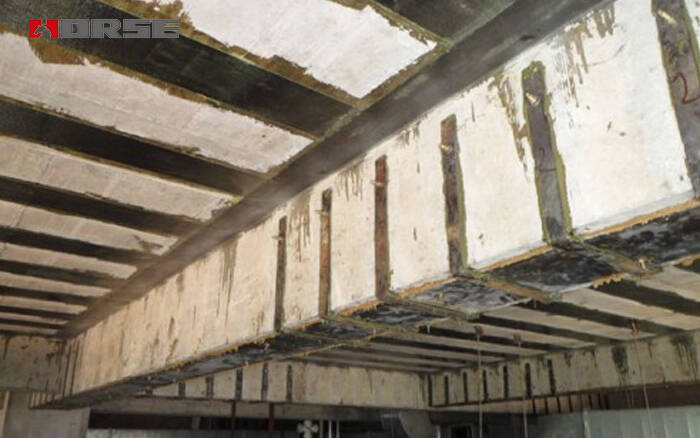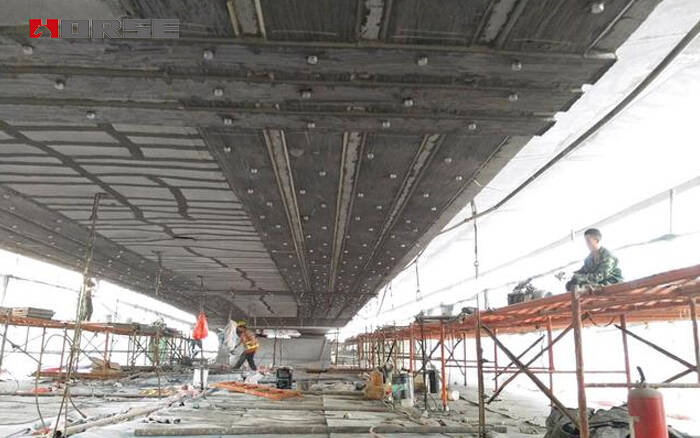Refuerzo de vigas
Reforzado con placas de acero unidas
Como un importante método técnico para el refuerzo de puentes, el método de placas de acero adhesivas se caracteriza por su alta resistencia, alta eficiencia, fácil manejo y bajo costo. Se puede aplicar a diversas estructuras y componentes de puentes. En los últimos años, se ha aplicado gradualmente en proyectos de refuerzo de puentes.

Con el paso del tiempo, los puentes en funcionamiento se deterioran gradualmente y su capacidad portante se reduce. Para mejorar la capacidad portante y prolongar su vida útil, es necesario reforzarlos. El método de placas de acero adhesivas, un importante método técnico para el refuerzo de puentes, se caracteriza por su alta resistencia, eficiencia, facilidad de uso y economía. Se puede aplicar a diversas estructuras y componentes estructurales de puentes. En los últimos años, se ha aplicado gradualmente en proyectos de refuerzo de puentes.
Actualmente, investigadores nacionales e internacionales se centran en la "tensión puntual" al investigar vigas de hormigón armado reforzadas con placas de acero adhesivas, es decir, en proyectos de refuerzo reales, en la zona de compresión de elementos flexurales reforzados con placas de acero adhesivas. Generalmente, el cálculo se realiza en función de la tensión puntual de vigas de doble cara, y el estudio experimental se centra en la influencia de la posición y la relación ancho-espesor de las placas de acero en la capacidad portante de las vigas reforzadas. En contraste, existe poca investigación sobre el refuerzo de vigas de hormigón armado mediante el pegado de placas de acero bajo cargas secundarias; solo se realiza el análisis de las características mecánicas y el cálculo de la capacidad portante de la sección normal de los elementos de hormigón armado con placas de acero.
El actual "Código de Diseño de Refuerzo de Puentes de Carretera" estipula: "Antes de pegar las placas de acero, los elementos reforzados deben descargarse". Por lo tanto, la tensión del hormigón y de la placa de acero deben tenerse en cuenta en la fórmula de cálculo de la capacidad portante, y debe limitarse el aumento de la capacidad portante de diseño de la viga reforzada. Se verifica la cantidad máxima y la deformación de las placas de acero adheribles bajo carga, en lugar de aplicar simplemente la fórmula de cálculo de la capacidad portante de las estructuras de hormigón armado. Dado que el diseño no considera la situación real, no solo se desperdicia acero, sino que también causa deterioro de la ductilidad, aumento de la fragilidad, aumento de la deformación y el comportamiento sísmico de los elementos después del refuerzo, por lo que se debe prestar la debida atención. Por tanto, a partir de la suma de los logros existentes y combinándolos con ejemplos de ingeniería, este trabajo deduce la fórmula de cálculo de la capacidad de flexión real de las vigas reforzadas mediante placas de acero pegadas.

1) Considerando la influencia de la fuerza secundaria, la fórmula teórica de la capacidad portante última de vigas de hormigón armado reforzadas con placas de acero se deduce aplicando la teoría de la mecánica elástica, que difiere de la fórmula sin considerar la influencia de la fuerza secundaria.
2) Tras el refuerzo de las vigas de hormigón armado con placas de acero, la tensión secundaria influye en la altura de la zona límite de compresión en condiciones de fallo de la armadura, y su influencia está relacionada con la tensión inicial del elemento original. De acuerdo con la fórmula para calcular la cantidad máxima de placas de acero adheridas requeridas en la zona de tracción, se puede evitar el fallo frágil de las vigas reforzadas y reducir el desperdicio de placas de acero reforzadas, lo que proporciona una referencia para el cálculo y análisis de elementos de hormigón armado sometidos a flexión.
3) La fórmula de cálculo de la capacidad portante de estructuras de hormigón armado reforzadas con placas de acero en el actual Código de Diseño de Puentes de Carreteras debe considerar la magnitud del aumento de la capacidad portante, la cantidad máxima de placas de acero a unir, la relación esfuerzo-deformación real de la estructura en el proceso de refuerzo y la influencia de la fuerza secundaria en el efecto de refuerzo.